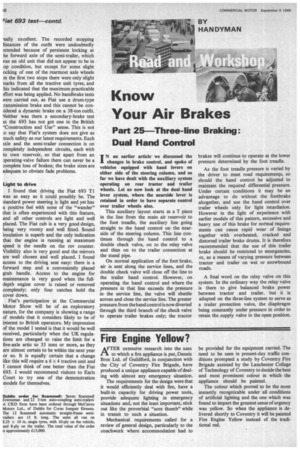Know Your Air Brakes
Page 48

If you've noticed an error in this article please click here to report it so we can fix it.
Part 25—Three-line Braking: Dual Hand Control
N an earlier article we discussed the changes In brake control, and spoke of vehicles equipped with hand levers on either side of the steering column, and so far we have dealt with the auxiliary system operating on rear tractor and trailer wheels. Let us now look at the dual hand lever system, where the nearside lever is retained in order to have separate control over trailer wheels also.
This auxiliary layout starts at a T piece in the line from the main air reservoir to the foot treadle, the auxiliary line going straight to the hand control on the nearside of the steering column. This line continues through the hand control to a double check valve, on to the relay valve and then on to the trailer connection at the stand pipe.
On normal application of the foot brake, air is sent along the service lines, and the double check valve will close off the line to the trailer hand control. However, on operating the hand control and where the pressure in that line exceeds the pressure in the service line, the valve will shuttle across and close the service line. The greater pressure from the hand control is now diverted through the third branch of the check valve to operate trailer brakes only; the tractor brakes will continue to operate at the lower pressure determined by the foot treadle.
As the foot treadle pressure is varied by the driver to meet road requirements, so should the hand control be adjusted to maintain the required differential pressure. Under certain conditions it may be an advantage to do without the footbrake altogether, and use the hand control over trailer wheels only for light retardation. However in the light of experience with earlier models of this pattern, excessive and heavy use of this brake for normal requirements can cause rapid wear of linings together with overheated, cracked and distorted trailer brake drums. It is therefore recommended that the use of this trailer brake should be restricted to emergencies, or, as a means of varying pressure between tractor and trailer on wet or snowbound roads.
A final word on the relay valve on this system. In the ordinary way the relay valve is there to give balanced brake power between tractor and trailer, but it is adapted on the three-line system to serve as a trailer protection valve, the diaphragm being constantly under pressure in order to retain the supply valve in the open position.
































































































































